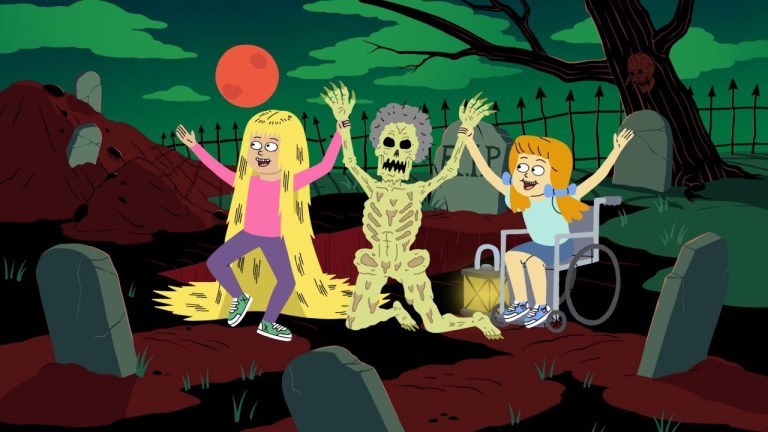Putting The Grim Back In Grimm’s Fairy Tales With JJ Villard
We talk with the creator of Adult Swim’s newest series about his insane takes on classic fairy tales and pushing animation to scary places.

Adult Swim has become the primary destination for the weirdest and most ambitious animated programs on television and their latest series, JJ Villard’s Fairy Tales is no exception to the rule. The show takes the subversive, experimental comedy and animation of JJ Villard (King Star King, Trap Universe pilot) and pairs it together with the innocence of children’s fairy tales.
The end result is something truly unique that manages to push old-fashioned fairy tales to unexpected and outrageous. This series has a very dangerous energy that helps make this animated show stand out and feel different. In honor of JJ Villard’s Fairy Tales upcoming invasion of Adult Swim, the series creator, JJ Villard himself, takes some time to discuss his new show’s origins, the heavy horror influence on the program, and where future seasons might be headed.
DEN OF GEEK: What was your relationship with fairy tales as a child and why did you want to do a show like this that re-appropriates them?
JJ VILLARD: I was more into Aesop’s Fables as a child, but what really brought all of this on was that Mike Laszlo—the guy who created Adult Swim—he saw a sketchbook page of mine that had Snow White drawn on it, but in a kind of Disney font, that featured all sorts of fairy tales creatures. He loved the look, so he asked me if I wanted to do a show about fairy tales, based off of that page from out of my sketchbook. I was like, “Fuck yeah! Let’s do it!
Your pilot for Trap Universe also had you taking a bunch of normal and “safe” images and then putting them in a surreal place. Is there a level of satisfaction in subverting these things or possibly surprising audiences?
That was definitely the challenge, to be able to take these well-known stories and make them feel fresh. The look and style of the show is very charming. It’s based off of these Little Golden Books, which are kind of well known, especially the vintage ones. So to take that charming look and combine with a really dark and gritty level of storytelling was very appealing to me. A part of the problem was that we also didn’t want to get too far away from what the original fairy tales were. I kept having to lure in and tone down the writers to bring them back closer to the source material.
There’s such a schizophrenic style to the animation where nothing plays by conventional rules. Do you just let the animators kind of run wild with whatever they’re working on? How are those crazier elements being determined?
They’re all based off of the storyboards and I do the storyboards for every episode. Something that was really challenging that I put myself through is that I over-boarded each episode. So when we ship it over to the animators in Korea they really have a good idea of what this should look like due to the thorough job that I’ve done. The average storyboard for a standard 11-and-a-half minute cartoon is around maybe 800-900 storyboards. I was handing in around 1400 boards per episode.
That’s insane. I noticed that you were the only storyboard artist, but I didn’t think that meant you were doing it all on your own.
Yeah, well some of my favorite episodes of Ren & Stimpy or Twin Peaks were the episodes where the creators were directing. They were just weirder. I get scared—and it’s really selfish as a creator to want to take everything under your own hand—but that’s just what I did. I storyboarded it all and we only went three weeks over schedule, but also under budget, which is just insane.
We also had no recurring characters! I was a character designer on the show, too. Matt Taylor and I character designed it all and we really stepped up. It’s a challenge when you don’t have recurring characters. Everything does and you get to know those characters in new ways. Even South Park, the facial expressions are pushed a lot differently now than in season one because those characters have changed and developed. It was all so much fun to make.
That difference probably pushes you to inherently come up with crazier character designs that stand out more. Prince Lionel, for instance, is just insane.
That’s so funny that you mentioned Prince Lionel because that’s exactly who I had in mind while you were saying that. With characters like Prince Lionel it’s a train with no brakes once you start production. You aren’t allowed to get into character designs to the same level of detail that you could with the pilot. Back on Seinfeld, Larry David got so stressed when the show got picked up because he was like, “The pilot was so hard to make, how am I going to do more?” That’s exactly how I feel and I kind of operate and use that fear. You’ve got to make friends with the fear and it will drive you. It’s all about what makes you laugh and what makes your peers laugh.
We were actually late with the voice casting for Prince Lionel. It was the one time in the entire season that we were late, but we let down Keith David, who’s just a consummate professional. He’s such a busy man and we kind of screwed him over, but once he started to read the script he had such a fun time with it. He really gets into the part.
On the topic of casting, there are a lot of influences from the horror genre in this series, especially when it comes to the casting. Why did you want to embrace all of that so much here?
Part of the thing there was that I came to understand that star power is a very real thing. I’ve always been a strong believer in keeping the animation sacred and not just turning to a bunch of stunt casting for voices, but I learned a lot from when my pilot for Trap Universe didn’t become a series. I really looked at what I did wrong there and part of it was the realization that I didn’t have any celebrities in it.
So for this show I really kept that in mind and thought about the actors that I admire and want to work with, who all turned out to be people from the horror genre. That’s what’s exciting to me and gets me up in the morning. It’s a dream to work with people like Linda Blair, Robert Englund, and Doug Bradley. We just started to hit up actors and we got a lot of enthusiastic responses back, as well as a bunch of people who turned it down, too.
I loved seeing that you’ve played into the cast’s history in the horror genre too, like using Warwick Davis to voice Rumplestiltskin
Warwick was a dream, but Linda Blair was the first actor that came in and she practically interviewed me for the position. She flipped things around on me. I was really nervous with her because The Exorcist is my favorite film. She asked me why I wanted to work with her and I didn’t want to sound trite, but I just told her that I truly believe she’s the greatest actor of all-time. She said, “You just made me cry,” and she was in.
It was nerve-wracking though because at Cartoon Network Studios the recording booths are big enough that I can get in there with the actor. My rhythm with her was so off though because I was nervous over the whole thing! She was an A+, but I was operating at a B-. Thank God we had her in for another role so that I could redeem myself around her. The next day when Robert Englund was in I was finally able to get out of my head and take charge, but it was a lot to be around with all of these idols of mine.
Even the score in this show pays reference to horror with how it lifts from Stanley Kubrick. How did you decide on that style of music for the series?
Well the whole thing there is that I wanted to fight what people are used to seeing with Grimm’s Fairy Tales, but to still be tasteful. So I was thinking about what movies I love and Mandy came up, who has music done by Jóhann Jóhannsson and Kubrick’s choice of music always stand out to me. So when I showed my composer that I wanted something like The Shining’s score for the “Boypunzel” episode, he told me that that’s public domain and free to use! I thought Kubrick created that on his own, but it’s from like the 14th century and composed by a bunch of monks.
The use of subliminal messages and hidden jump scares is a running theme in your works, but why did you want to include it again here?
I’ve been doing that since college. My college film, Son of Satan, is full of that. My sketchbook is just something that I always have with me and I hold it so dear. It’s just full of pictures, quotes I hear, quotes I think, and just any kind of drawings. It’s everything that means anything to me. So taking the aesthetic of my sketchbook and translating it over to my animation makes perfect sense to me. It’s just sketchbook stuff coming through in another context.
It’s just what I do. It’s not a gimmick or anything, but just something that I’ve been doing forever. Today especially, there’s just so much coming at us all the time and stealing our attention. I get at that in a very tame way here with visuals and quotes, but that’s what I’m going for. It’s everything at once.
You mentioned Aesop’s Fables earlier, but do you see the series strictly sticking with fairy tales, or do you see it slowly expanding to cover other territory like nursery rhymes or fables?
Absolutely. Future seasons are already in discussion. We did Grimm’s this year, so we’re looking towards other things like American folklore, Bible stories, or even just looking at fairy tales from entirely different countries and cultures. I really want the show’s scope to broaden a lot.
JJ Villard’s Fairy Tales premieres on Adult Swim on May 10 at 12:15am (ET)
